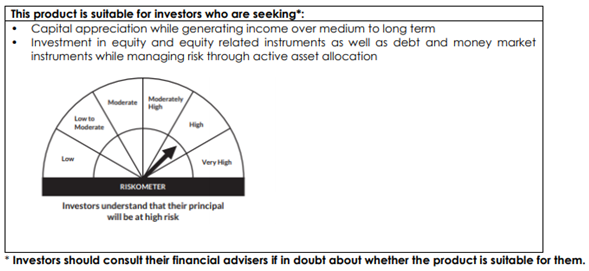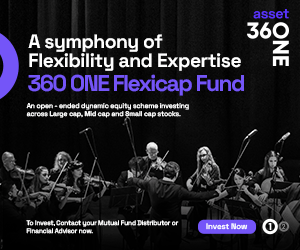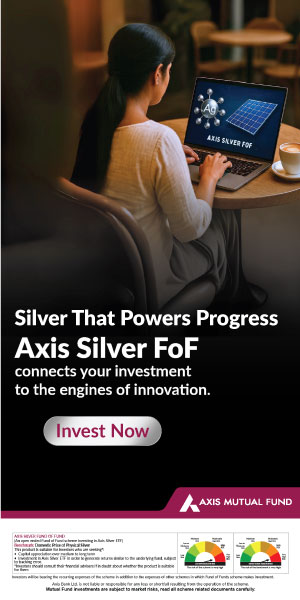Should you invest in Dynamic Asset Allocation Funds: Axis Dynamic Equity Fund

The stock market staged a big turnaround after the big crash in March of 2020. The market (Sensex / Nifty) is now trading near its all-time high. Many investors may be wondering what do now. Asset allocation helps investors balance risk and returns. Research has shown that asset allocation is one of the most important factors in portfolio performance. There are broadly two types of asset allocation strategies:-
- Static asset allocation: In this strategy, asset allocation (i.e. equity and fixed income allocations) is maintained within certain ranges irrespective of market movements. Hybrid funds which follow this strategy specify the ranges of equity and fixed income allocations in their Scheme Information Document (SID). For example, an aggressive hybrid fund may maintain equity allocation between 65 – 80% and fixed income allocation between 20 – 35% (please refer to the SIDs to know about the asset allocation ranges of different hybrid funds).
- Dynamic asset allocation: In this asset allocation strategy, you continuously adjust your asset allocation mix depending on market conditions i.e. you will increase or decrease your allocations to equity and fixed income on an on-going basis depending on market movements using some models which have been back-tested to check their performance in different market conditions. Funds which follow this strategy are called dynamic asset allocation or balanced advantage or dynamic equity funds.
Benefits of dynamic asset allocation funds
- Dynamic asset allocation is based on a set of rules (mathematical models) which changes asset allocation based on market conditions instead of relying on human judgement.
- Dynamic asset allocation is aimed at reducing risk depending on market conditions e.g. a dynamic asset allocation fund may reduce equity exposure when the market is high.
- Dynamic asset allocation funds aim at providing stability across different market conditions – they change their risk profile depending on market conditions. It is done with the view of optimizing risk and return over sufficiently long investment horizons.
- Dynamic asset allocation funds usually enjoy equity taxation since they use hedging / arbitrage to reduce active (net) equity exposure depending on market conditions. However, investors should consult with their financial advisors to know the taxation of hybrid funds before investing.
Asset Allocation
- Equity: Dynamic asset allocation funds usually try to maintain minimum 65% gross equity exposure to ensure equity taxation. Net equity allocation is determined by the dynamic asset allocation model of the scheme. The difference between gross and net equity exposures is covered by hedging.
- Fixed income: Fixed income allocation is determined by the asset allocation model. In order to ensure equity taxation, these schemes usually cap fixed income allocation at 35%.
- Arbitrage: The hedged portion of the portfolio has three objectives. (1) Reduce risk (net equity exposure), (2) ensure equity taxation and (3) generate arbitrage (risk free) profits by exploiting price differences of the same underlying asset in different market segments e.g. cash and derivatives segments.
Types of dynamic asset allocation models
- Counter-cyclical dynamic asset allocation: Hybrid schemes using this strategy gradually reduce equity exposure when valuations increase and vice versa. These schemes essentially follow the age old investment wisdom of buying low and selling high.
- Pro-cyclical dynamic asset allocation: A fewhybrid schemes using this strategy usually follow the market trend. They increase equity exposure when market is rising and reduce it when markets are falling. Pro-cyclical funds aim to benefit from momentum.
Most dynamic asset allocation hybrid funds follow the counter-cyclical approach. Some schemes may have a combined approach, where they use valuation based counter-cyclical asset allocation as part of their core approach and pro-cyclical asset allocation as a tactical approach.
Axis Dynamic Equity Fund
Axis Dynamic Equity Fund is a dynamic asset allocation hybrid fund, using a back-tested counter-cyclical dynamic asset allocation model. The scheme was launched in August 2017 and has Rs 1,309 Crores of assets under management (source: Axis MF Factsheet January). Mr. Anupam Tiwari and R. Sivakumar are the fund managers of the scheme.
Asset Allocation - Axis Dynamic Equity Fund
- Net Equity: 30 – 100%
- Hedged Equity: 0 – 35%
- Fixed Income: 0 – 35%
Source: Axis Dynamic Equity Fund Scheme Information Document
Asset allocation Model - Axis Dynamic Equity Fund
- The model throws the net equity allocation based on 3 factors – (1) Price Earnings Multiple (PE) as a measure of market valuations, (2) trend or Market direction and (3) volatility as measure of market risk.
- Minimum total gross equity exposure will be maintained at 65%. This will ensure equity taxation for the scheme. Short term capital gains (investment holding period of less than 12 months) will be taxed at 15%. Long term capital gains (investment holding period of more than 12 months) of up to Rs 1 lakh will be tax exempt and taxed at 10% thereafter.
- The difference between gross and net equity exposure is managed through hedging.
- The asset allocation is rebalanced every two months. Latest rebalancing has been done in February 21.
For more details on asset allocation of Axis Dynamic Equity Fund, please refer to the scheme information document.
Back-testing results - Axis Dynamic Equity Fund
Back-testing results show that the model has outperformed Nifty 50 in volatile and flat markets and underperformed Nifty 50 in rising markets. In the long term (1999 to 2020) the model has outperformed Nifty.

Source: Axis MF Presentation (Jan 2021). *Axis Dynamic Equity Fund asset allocation model. Disclaimer: Past performance may or may not be sustained in the future
From calendar year 2020 to calendar year 2020, the model has given negative returns in only two calendar years, while Nifty 50 gave negative returns in 5 calendar years (Source: Axis MF Presentation (Jan 2021).
Who can invest in Axis Dynamic Equity Fund?
- Investors who are looking for capital appreciation in the long term.
- Investors who have long investment horizon – in our view, you should have investment tenure of at least 3 to 5 years for this scheme.
- Investors with high risk appetites, who want to limit downside risks in volatile markets.
- This scheme may be suitable for new investors because it may be less volatile than equity funds and aggressive (equity oriented) hybrid funds.
- Investors who want to enjoy equity taxation.
- Investors should consult with their financial advisors if Axis Dynamic Equity Fund is suitable for their investment needs. You should read the scheme information document or ask your financial advisor if you have any question before investing.
AXIS Dynamic Equity Fund – An open ended Dynamic Asset Allocation Fund

Mutual Fund Investments are subject to market risk, read all scheme related documents carefully.
Queries
-
What is the benefit of mutual fund STP
Aug 29, 2019
-
How much to invest to meet target amount of Rs 2 Crores
Aug 26, 2019
-
Can I achieve my financial goals with my current mutual fund investments
Aug 24, 2019
-
Can you tell me return of various indices
Aug 19, 2019
-
What would be the post tax return on different investments
Aug 18, 2019
-
Which Principal Mutual Fund scheme will be suitable for my retirement corpus
Aug 16, 2019
-
What is the minimum holding period for availing NCD interest
Aug 4, 2019
Top Performing Mutual Funds
Recommended Reading
Fund News
-
Jio BlackRock Mutual Fund launches Jio BlackRock Short Duration Fund
Jan 8, 2026 by Advisorkhoj Team
-
Jio BlackRock Mutual Fund launches Jio BlackRock Low Duration Fund
Jan 8, 2026 by Advisorkhoj Team
-
Groww Mutual Fund launches Groww Small Cap Fund
Jan 8, 2026 by Advisorkhoj Team
-
Bank of India Mutual Fund launches Bank of India Banking and Financial Services Fund
Jan 8, 2026 by Advisorkhoj Team
-
Sundaram Mutual Fund launches Sundaram Income Plus Arbitrage Active FoF
Jan 5, 2026 by Advisorkhoj Team














